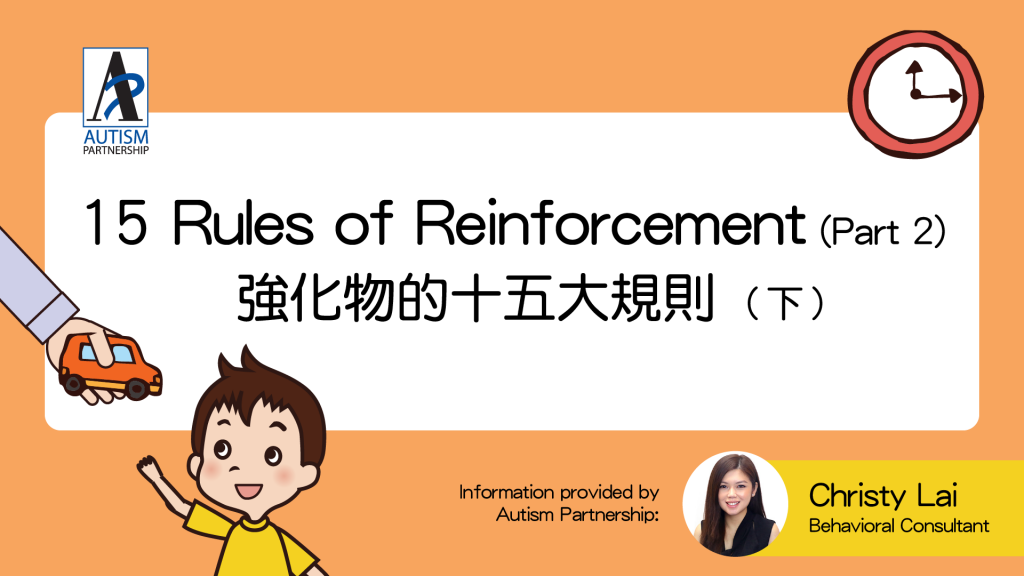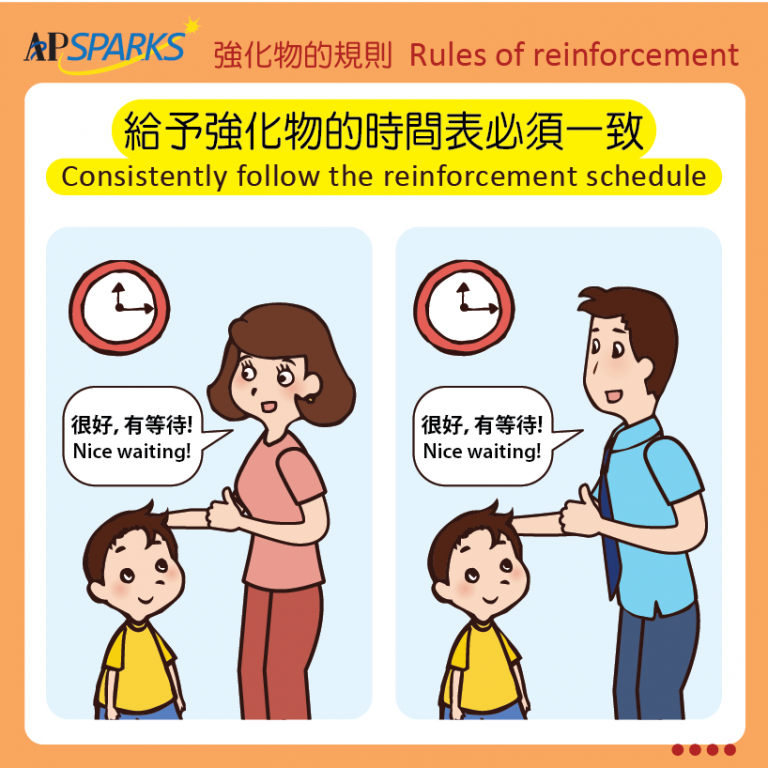
In this article, we will continue sharing the remaining 7 rules of reinforcement with you.

9. Consistently follow the reinforcement schedule
A predictable schedule of reinforcement is likely to increase the child’s chance of displaying the desired behavior (e.g., if the child gets the reinforced every time he displays the desired behavior, nice waiting, the chance of the child waiting nicely in the future will increase, because the child anticipates that he will get reinforced when he waits well). On the contrary, if the child waits well and is not reinforced, the desired behavior will reduce. Similarly, if a child is reinforced when he is displaying the undesired behavior, desired behavior will reduce. This is especially important for children during the beginning phase of learning the skills. When we plan on reducing the intensity of the reinforcement in the future (i.e., the child needs to work for a little longer in exchange for the reinforcement) (see rule 10 below), all members of the family/treatment team should be consistent in implementing it.
10. Systematically fade the use of reinforcement over time
The longer we use a high-intensity schedule of reinforcement, the more difficult it becomes for children to get rid of these external reinforcers. At the same time, when we reduce the intensity of the schedule of reinforcement, the chance of displaying the desired behavior may decrease. It is important for us to fade the schedule of reinforcement systematically and gradually.
11. Constantly evaluate the timing of reinforcement
The process of fading the schedule of reinforcement may not be as smooth as we plan, we need to make adjustment based on the child’s performance. Sometimes, we may even have to move back to a higher intensity schedule of reinforcement.
Also, we need to make a good balance of the difficulty and novelty of the tasks and the schedule and value of the reinforcement. When we are working on a skill that is more difficult or new to the child, it is likely that we may need to use some strong reinforcers or increase the intensity of the schedule of reinforcement.
12. During beginning phase, label the behavior that is being reinforced
Labelling the behavior is helpful in helping the child understand the target behavior and increases his chance of displaying the appropriate behavior in the future. At the same time, this can strengthen the child’s understanding of the association between the reinforcement and the appropriate behavior.
Labelling the behavior can also keep parents/teachers to focus on the behavior/teaching objective and reduce the chance of being distracted by other behaviors. This process is less important when your child understands the relationship between the target behavior and the reinforcement.

13. Gradually switch to more natural/ easily accessible reinforcer
It is critical that we try to use natural reinforcers as much as possible to further help our child generalize the skills into different environment. As we all know, natural reinforcers are easier to find in the natural environment. The disadvantage of external reinforcers is that they are more difficult to find in the natural environment. Therefore, the child may not perform the same when the reinforcers are not available in other natural settings.

14. Be aware of bribery
Avoid telling your child what reinforcers he will be getting before the training session. Ideally, the child will select his reinforcer after each training session and when he displays the desired behavior. Choosing the reinforcer after the training session will help in fading the reinforcer smoothly later on. But for some children, especially those engage in high level of self-stimulatory behavior, we may need to have them choose the reinforcers before the training session to remind them of their motivation, but we should also fade this procedure once they understand the reinforcement contingency. Never bribe when your child is engaging in undesired behavior, for example, when a child loses his temper, you tell him that he can get the reinforcer as soon as he stops. It is often effective with an immediate effect, but it is also risky. You do not want to bargain with your child every time (e.g. if you stop crying, I’ll give you the phone). What is even worse is that your child needs to rely on bribes to obey. It increases the child’s dependence on reinforcers and prevent the child from making smart choices.
15. Use differential reinforcement :
It is a pretty straightforward idea. Paying effort and trying hard will bring the child the strongest and the most powerful reinforcers and praise (e.g. Perfect, full score, excellent!) Average performance (e.g. the child is focused but did not respond correctly) will result in average reinforcers as well as comments (e.g. good try, almost, etc.) At the same time, when the child is not paying any effort, we would give more serious comments and use a more serious tone of voice (e.g.: Not listening, Not paying attention, wrong etc.) In addition to the value of the reinforcers, the tone of the parents’ feedback (e.g. excited vs. serious) and facial expressions (e.g. happy vs. serious looks) can also help our child better understand our expectation.
Ms. Christy Lai is a Board Certified Behavior Analyst with a Master of Science in Applied Behavior Analysis from St. Cloud State University and a Bachelor of Arts in Psychology from the University of Michigan, Ann Arbor. Ms. Lai joined Autism Partnership (AP) in 2011 and she has extensive experience in working with children with ASD. Ms. Christy Lai currently take lead of the case supervision in the new established AP Beijing center. At the same time, she oversees the Little Learners program in Hong Kong and Shanghai and consults families in Asia. She directs overseas training to staff in the Train the Trainer program and provides parent education to families with children with ASD. She also conducts Jumpstart and PIIP programs locally and internationally. In additions, she is keen to take part in overseas ASD conferences and take lead of the design and production of AP teaching materials. Moreover, she helps with producing ABA training videos and articles in the APSPARKS website for public education.

Every little life is a special present for a family. From the time a baby is born, parents journey through lots of highs and lows, wishing for their child to grow up with a big smile, make great friends, find their own way in a job they love, and create a happy family. However, for […]

Autism Spectrum disorder can be diagnosed as early as 18 months. Research shows strong evidence on how effective Applied Behavior Analysis (ABA) can help children with Autism. It helps to deal with children’s challenging behaviors such as inattention, aggression, self-stimulation, etc. Howard, et al (2005) conducted a study to compare the effectiveness of 3 treatment […]

In today’s society where information flows freely, parents can easily receive different messages. However, these messages are often debatable or even wrong. Believing wrong information can easily lead to misguided choices and delay treatment, the consequences of which may last a lifetime. When conducting one-on-one consultations with parents, I often hear the following misguided views […]
Please share to let more people learn about ASD and ABA therapy:
AP holds the belief that with quality Autism Partnership Method (APM) treatment, individuals with autism should reach their fullest potential and achieve the greatest degree of independence and highest quality of life possible.

Sign up now to get ABA and Autism related news delivered to your inbox. Enter your email to get started
Hong Kong Center
Kowloon Center

All information received will always remain confidential. We will contact you as soon as we review your message. Thanks